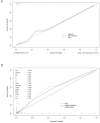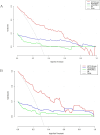Establishment and validation of a prognostic nomogram for severe fever with thrombocytopenia syndrome: A retrospective observational study
- PMID: 39446786
- PMCID: PMC11500966
- DOI: 10.1371/journal.pone.0311924
Establishment and validation of a prognostic nomogram for severe fever with thrombocytopenia syndrome: A retrospective observational study
Abstract
Background: Several scoring systems have been proposed to predict the risk of death due to severe fever with thrombocytopenia syndrome (STFS), but they have limitations. We developed a new prognostic nomogram for STFS-related death and compared its performance with previous scoring systems and the Acute Physiology and Chronic Health Evaluation score (APACHE II Score).
Methods: A total of 292 STFS patients were retrospectively enrolled between January 2016 and March 2023. Boruta's algorithm and backward stepwise regression were used to select variables for constructing the nomogram. Time-dependent receiver operating characteristic (ROC) curves and clinical decision curves were generated to compare the strengths of the nomogram with others.
Results: Age, Sequential Organ Failure Assessment Score (SOFA score), state of consciousness, continuous renal replacement therapy (CRRT), and D-dimer were significantly correlated with mortality in both univariate and multivariate analyses (P<0.05). We developed a nomogram using these variables to predict mortality risk, which outperformed the SFTS and APACHE II scores (Training ROC: 0.929 vs. 0.848 vs. 0.792; Validation ROC: 0.938 vs. 0.839 vs. 0.851; P<0.001). In the validation set, the SFTS model achieved an accuracy of 76.14%, a sensitivity of 95.31%, a specificity of 25.00%, a precision of 77.22%, and an F1 score of 85.32%. The nomogram showed a superior performance with an accuracy of 86.36%, a precision of 88.24%, a recall of 93.75%, and an F1 score of 90.91%.
Conclusion: Age, consciousness, SOFA Score, CRRT, and D-Dimer are independent risk factors for STFS-related death. The nomogram based on these factors has an excellent performance in predicting STFS-related death and is recommended for clinical practice.
Copyright: © 2024 Yang et al. This is an open access article distributed under the terms of the Creative Commons Attribution License, which permits unrestricted use, distribution, and reproduction in any medium, provided the original author and source are credited.
Conflict of interest statement
The authors have declared that no competing interests exist.
Figures







Similar articles
-
Construction and validation of a dynamic nomogram using Lasso-logistic regression for predicting the severity of severe fever with thrombocytopenia syndrome patients at admission.BMC Infect Dis. 2024 Sep 18;24(1):996. doi: 10.1186/s12879-024-09867-z. BMC Infect Dis. 2024. PMID: 39294596 Free PMC article.
-
Development and validation of a clinical and laboratory-based nomogram to predict mortality in patients with severe fever with thrombocytopenia syndrome.BMC Infect Dis. 2024 Oct 25;24(1):1206. doi: 10.1186/s12879-024-10106-8. BMC Infect Dis. 2024. PMID: 39455906 Free PMC article.
-
Risk Factors for Death in Patients with Severe Fever with Thrombocytopenia Syndrome.Am J Trop Med Hyg. 2023 May 30;109(1):94-100. doi: 10.4269/ajtmh.22-0667. Print 2023 Jul 5. Am J Trop Med Hyg. 2023. PMID: 37253446 Free PMC article.
-
A nomogram including admission serum glycated albumin/albumin ratio to predict mortality in patients with severe fever with thrombocytopenia syndrome.BMC Infect Dis. 2024 Aug 23;24(1):858. doi: 10.1186/s12879-024-09752-9. BMC Infect Dis. 2024. PMID: 39179974 Free PMC article.
-
A nomogram to predict mortality in patients with severe fever with thrombocytopenia syndrome.Sci Rep. 2024 May 9;14(1):10627. doi: 10.1038/s41598-024-60923-9. Sci Rep. 2024. PMID: 38724615 Free PMC article.
Cited by
-
Prediction of Mortality by Clinical Laboratory Parameters in Severe Fever with Thrombocytopenia Syndrome: A Meta-Analysis.Trop Med Infect Dis. 2025 Jul 9;10(7):193. doi: 10.3390/tropicalmed10070193. Trop Med Infect Dis. 2025. PMID: 40711070 Free PMC article. Review.
References
-
- Tian H, Yu P, Chowell G, Li S, Wei J, Tian H, et al.. Severe Fever with Thrombocytopenia Syndrome Virus in Humans, Domesticated Animals, Ticks, and Mosquitoes, Shaanxi Province, China. Am J Trop Med Hyg. 2017;96(6):1346–9. Epub 2017/07/19. doi: 10.4269/ajtmh.16-0333 ; PubMed Central PMCID: PMC5462569. - DOI - PMC - PubMed
-
- Takahashi T, Maeda K, Suzuki T, Ishido A, Shigeoka T, Tominaga T, et al.. The first identification and retrospective study of Severe Fever with Thrombocytopenia Syndrome in Japan. J Infect Dis. 2014;209(6):816–27. Epub 2013/11/16. doi: 10.1093/infdis/jit603 ; PubMed Central PMCID: PMC7107388. - DOI - PMC - PubMed
Publication types
MeSH terms
Substances
LinkOut - more resources
Full Text Sources

